The Changing Economies of Asia: Agriculture and Development
VerifiedAdded on 2020/05/16
|17
|3149
|48
Report
AI Summary
This report provides a comprehensive analysis of the changing economies of Asia, with a specific focus on the agricultural sector and its impact on economic development. It begins by outlining the key aspects of the agricultural sector and its contributions, followed by a brief history of the Green Revolution and its effects. The report then delves into the current problems facing agriculture, such as population growth, environmental concerns, and climate change. A significant portion of the report is dedicated to a case study of Taiwan, examining land reform policies, agricultural protectionism, and the role of agriculture in GDP, employment, and trade. The report highlights the importance of agriculture as a primary sector and its role in supplying raw materials, generating employment, and contributing to economic growth, particularly emphasizing the success of Taiwan's agricultural policies. The study also includes data and figures to support the analysis.
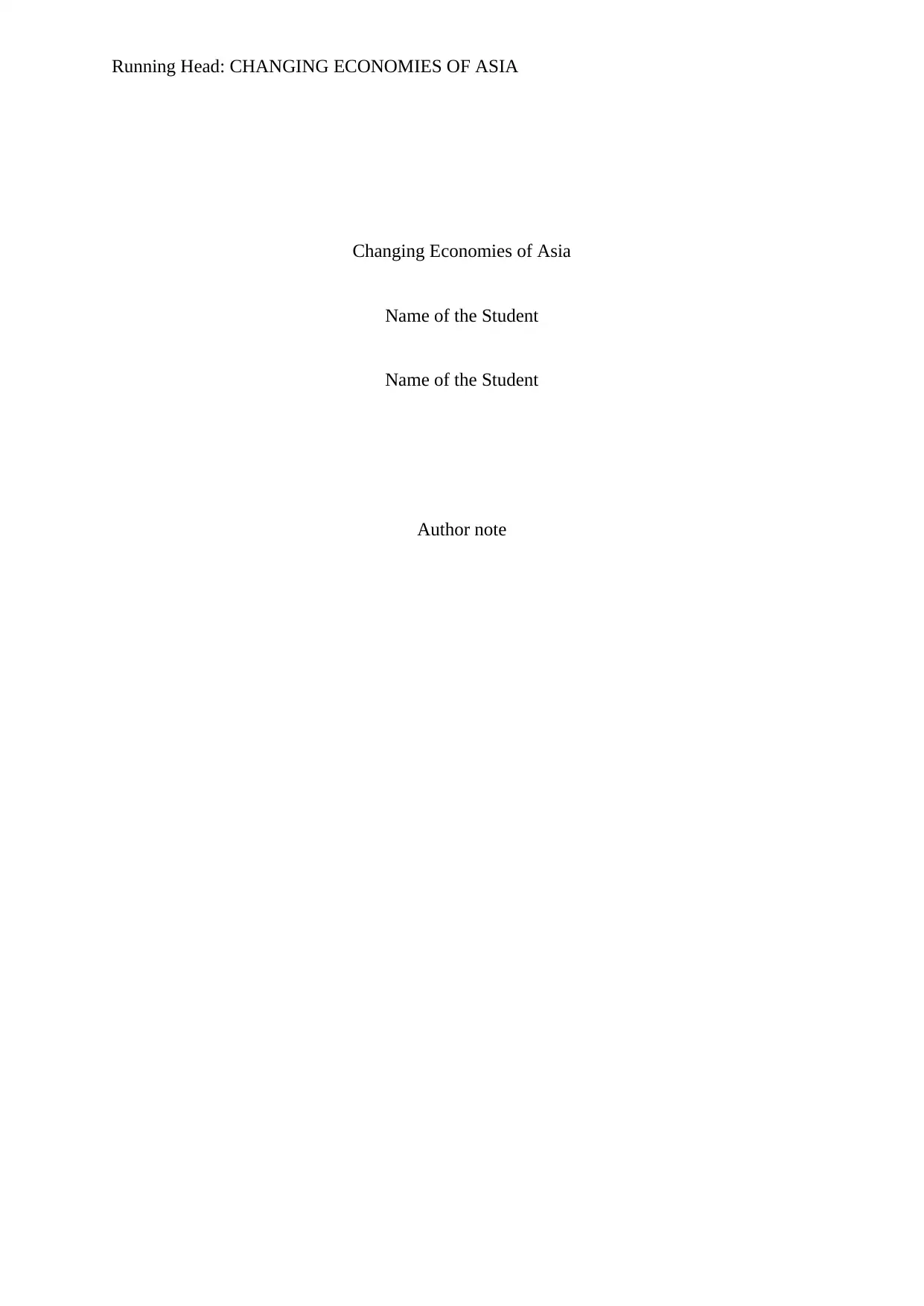
Running Head: CHANGING ECONOMIES OF ASIA
Changing Economies of Asia
Name of the Student
Name of the Student
Author note
Changing Economies of Asia
Name of the Student
Name of the Student
Author note
Paraphrase This Document
Need a fresh take? Get an instant paraphrase of this document with our AI Paraphraser
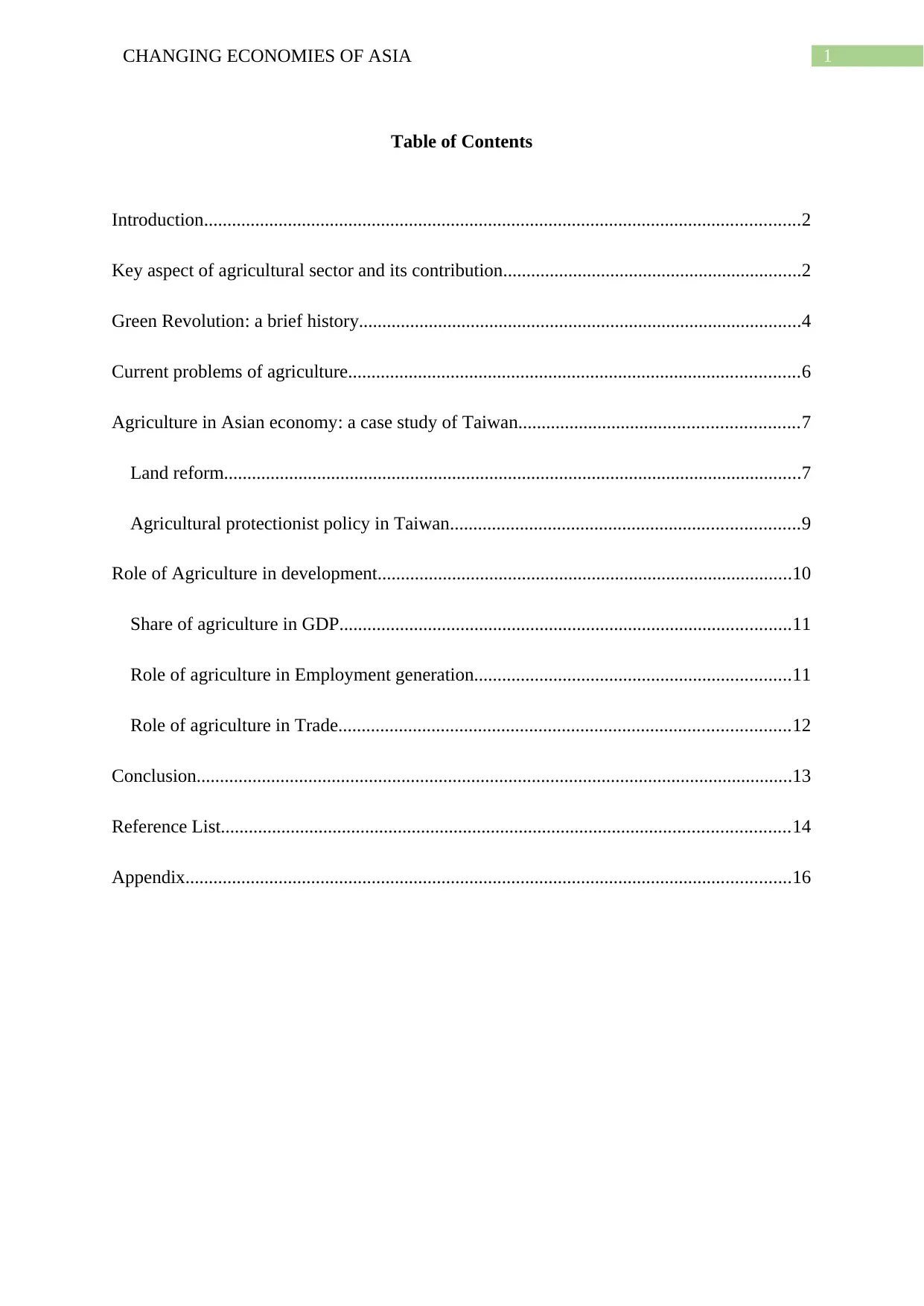
1CHANGING ECONOMIES OF ASIA
Table of Contents
Introduction................................................................................................................................2
Key aspect of agricultural sector and its contribution................................................................2
Green Revolution: a brief history...............................................................................................4
Current problems of agriculture.................................................................................................6
Agriculture in Asian economy: a case study of Taiwan............................................................7
Land reform............................................................................................................................7
Agricultural protectionist policy in Taiwan...........................................................................9
Role of Agriculture in development.........................................................................................10
Share of agriculture in GDP.................................................................................................11
Role of agriculture in Employment generation....................................................................11
Role of agriculture in Trade.................................................................................................12
Conclusion................................................................................................................................13
Reference List..........................................................................................................................14
Appendix..................................................................................................................................16
Table of Contents
Introduction................................................................................................................................2
Key aspect of agricultural sector and its contribution................................................................2
Green Revolution: a brief history...............................................................................................4
Current problems of agriculture.................................................................................................6
Agriculture in Asian economy: a case study of Taiwan............................................................7
Land reform............................................................................................................................7
Agricultural protectionist policy in Taiwan...........................................................................9
Role of Agriculture in development.........................................................................................10
Share of agriculture in GDP.................................................................................................11
Role of agriculture in Employment generation....................................................................11
Role of agriculture in Trade.................................................................................................12
Conclusion................................................................................................................................13
Reference List..........................................................................................................................14
Appendix..................................................................................................................................16
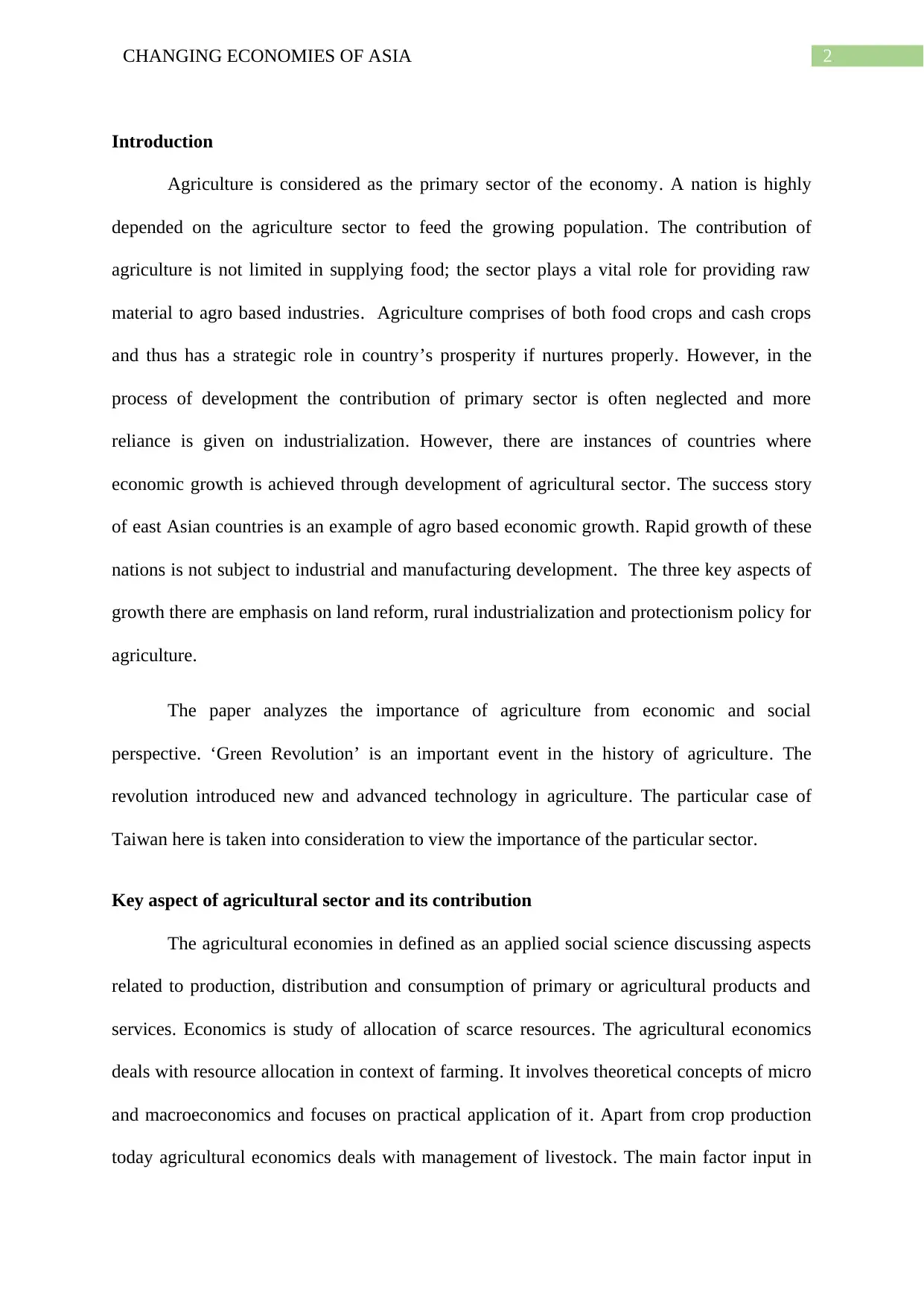
2CHANGING ECONOMIES OF ASIA
Introduction
Agriculture is considered as the primary sector of the economy. A nation is highly
depended on the agriculture sector to feed the growing population. The contribution of
agriculture is not limited in supplying food; the sector plays a vital role for providing raw
material to agro based industries. Agriculture comprises of both food crops and cash crops
and thus has a strategic role in country’s prosperity if nurtures properly. However, in the
process of development the contribution of primary sector is often neglected and more
reliance is given on industrialization. However, there are instances of countries where
economic growth is achieved through development of agricultural sector. The success story
of east Asian countries is an example of agro based economic growth. Rapid growth of these
nations is not subject to industrial and manufacturing development. The three key aspects of
growth there are emphasis on land reform, rural industrialization and protectionism policy for
agriculture.
The paper analyzes the importance of agriculture from economic and social
perspective. ‘Green Revolution’ is an important event in the history of agriculture. The
revolution introduced new and advanced technology in agriculture. The particular case of
Taiwan here is taken into consideration to view the importance of the particular sector.
Key aspect of agricultural sector and its contribution
The agricultural economies in defined as an applied social science discussing aspects
related to production, distribution and consumption of primary or agricultural products and
services. Economics is study of allocation of scarce resources. The agricultural economics
deals with resource allocation in context of farming. It involves theoretical concepts of micro
and macroeconomics and focuses on practical application of it. Apart from crop production
today agricultural economics deals with management of livestock. The main factor input in
Introduction
Agriculture is considered as the primary sector of the economy. A nation is highly
depended on the agriculture sector to feed the growing population. The contribution of
agriculture is not limited in supplying food; the sector plays a vital role for providing raw
material to agro based industries. Agriculture comprises of both food crops and cash crops
and thus has a strategic role in country’s prosperity if nurtures properly. However, in the
process of development the contribution of primary sector is often neglected and more
reliance is given on industrialization. However, there are instances of countries where
economic growth is achieved through development of agricultural sector. The success story
of east Asian countries is an example of agro based economic growth. Rapid growth of these
nations is not subject to industrial and manufacturing development. The three key aspects of
growth there are emphasis on land reform, rural industrialization and protectionism policy for
agriculture.
The paper analyzes the importance of agriculture from economic and social
perspective. ‘Green Revolution’ is an important event in the history of agriculture. The
revolution introduced new and advanced technology in agriculture. The particular case of
Taiwan here is taken into consideration to view the importance of the particular sector.
Key aspect of agricultural sector and its contribution
The agricultural economies in defined as an applied social science discussing aspects
related to production, distribution and consumption of primary or agricultural products and
services. Economics is study of allocation of scarce resources. The agricultural economics
deals with resource allocation in context of farming. It involves theoretical concepts of micro
and macroeconomics and focuses on practical application of it. Apart from crop production
today agricultural economics deals with management of livestock. The main factor input in
⊘ This is a preview!⊘
Do you want full access?
Subscribe today to unlock all pages.

Trusted by 1+ million students worldwide
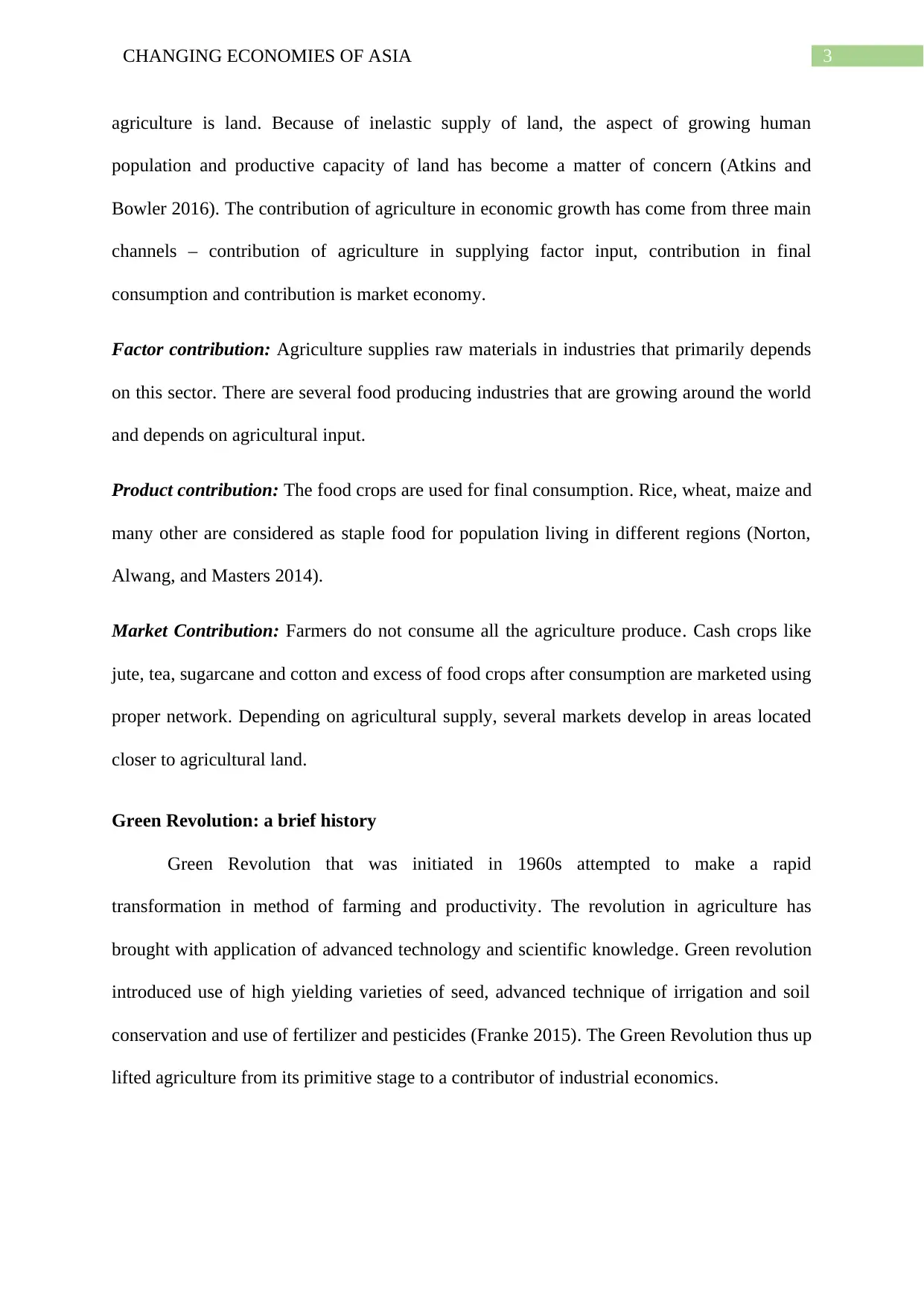
3CHANGING ECONOMIES OF ASIA
agriculture is land. Because of inelastic supply of land, the aspect of growing human
population and productive capacity of land has become a matter of concern (Atkins and
Bowler 2016). The contribution of agriculture in economic growth has come from three main
channels – contribution of agriculture in supplying factor input, contribution in final
consumption and contribution is market economy.
Factor contribution: Agriculture supplies raw materials in industries that primarily depends
on this sector. There are several food producing industries that are growing around the world
and depends on agricultural input.
Product contribution: The food crops are used for final consumption. Rice, wheat, maize and
many other are considered as staple food for population living in different regions (Norton,
Alwang, and Masters 2014).
Market Contribution: Farmers do not consume all the agriculture produce. Cash crops like
jute, tea, sugarcane and cotton and excess of food crops after consumption are marketed using
proper network. Depending on agricultural supply, several markets develop in areas located
closer to agricultural land.
Green Revolution: a brief history
Green Revolution that was initiated in 1960s attempted to make a rapid
transformation in method of farming and productivity. The revolution in agriculture has
brought with application of advanced technology and scientific knowledge. Green revolution
introduced use of high yielding varieties of seed, advanced technique of irrigation and soil
conservation and use of fertilizer and pesticides (Franke 2015). The Green Revolution thus up
lifted agriculture from its primitive stage to a contributor of industrial economics.
agriculture is land. Because of inelastic supply of land, the aspect of growing human
population and productive capacity of land has become a matter of concern (Atkins and
Bowler 2016). The contribution of agriculture in economic growth has come from three main
channels – contribution of agriculture in supplying factor input, contribution in final
consumption and contribution is market economy.
Factor contribution: Agriculture supplies raw materials in industries that primarily depends
on this sector. There are several food producing industries that are growing around the world
and depends on agricultural input.
Product contribution: The food crops are used for final consumption. Rice, wheat, maize and
many other are considered as staple food for population living in different regions (Norton,
Alwang, and Masters 2014).
Market Contribution: Farmers do not consume all the agriculture produce. Cash crops like
jute, tea, sugarcane and cotton and excess of food crops after consumption are marketed using
proper network. Depending on agricultural supply, several markets develop in areas located
closer to agricultural land.
Green Revolution: a brief history
Green Revolution that was initiated in 1960s attempted to make a rapid
transformation in method of farming and productivity. The revolution in agriculture has
brought with application of advanced technology and scientific knowledge. Green revolution
introduced use of high yielding varieties of seed, advanced technique of irrigation and soil
conservation and use of fertilizer and pesticides (Franke 2015). The Green Revolution thus up
lifted agriculture from its primitive stage to a contributor of industrial economics.
Paraphrase This Document
Need a fresh take? Get an instant paraphrase of this document with our AI Paraphraser

4CHANGING ECONOMIES OF ASIA
The major aspect of success brought by green revolution is the application scientific
technology in irrigation method, efficient fertilizer and pesticides and proficient crop seed.
This section gives a brief description of technologies used in green revolution.
Irrigation
A sustainable agriculture is subject to availability of water resources. In the era of
green revolution, countries were highly suffered from drought and inefficiencies of water due
to pollution. The inefficient irrigation technique was one factor causing drought aggravate
problems of water inefficiencies. Use of surface water for irrigation lead to scarcity of water.
In order to overcome the shortcomings of existing irrigation techniques the new method
focused on lowering the impact of drought and gave a higher protection to crops. Under new
system drip irrigation was used resulting in optimization of water use and water reached to
plants’ root (wordpress.com 2018). The new technique benefitted agriculture by reducing
growth of weed on agricultural land and reducing soil erosion.
Fertilizers
The advanced irrigation technique was supplemented with application of better
fertilizers. The green revolution focused on increasing food production through increased
harvesting of wheat, cereals and grains. The advancement of pesticides and fertilizers helped
to achieve this goal. Under the era of green revolution chemical based and inorganic
fertilizers were introduced (Goron and Raizada 2015). The new agricultural method adapted
during this time mostly used synthetic nitrogen based fertilizers. The use of nitrogen based
fertilizer increased the mineral contain in soils resulting in high crop yield.
Pesticides
In order to sustain crop growth, it is necessary to cure diseases or damages caused by
pests on farming land. For this, various types of pesticides were introduced during green
The major aspect of success brought by green revolution is the application scientific
technology in irrigation method, efficient fertilizer and pesticides and proficient crop seed.
This section gives a brief description of technologies used in green revolution.
Irrigation
A sustainable agriculture is subject to availability of water resources. In the era of
green revolution, countries were highly suffered from drought and inefficiencies of water due
to pollution. The inefficient irrigation technique was one factor causing drought aggravate
problems of water inefficiencies. Use of surface water for irrigation lead to scarcity of water.
In order to overcome the shortcomings of existing irrigation techniques the new method
focused on lowering the impact of drought and gave a higher protection to crops. Under new
system drip irrigation was used resulting in optimization of water use and water reached to
plants’ root (wordpress.com 2018). The new technique benefitted agriculture by reducing
growth of weed on agricultural land and reducing soil erosion.
Fertilizers
The advanced irrigation technique was supplemented with application of better
fertilizers. The green revolution focused on increasing food production through increased
harvesting of wheat, cereals and grains. The advancement of pesticides and fertilizers helped
to achieve this goal. Under the era of green revolution chemical based and inorganic
fertilizers were introduced (Goron and Raizada 2015). The new agricultural method adapted
during this time mostly used synthetic nitrogen based fertilizers. The use of nitrogen based
fertilizer increased the mineral contain in soils resulting in high crop yield.
Pesticides
In order to sustain crop growth, it is necessary to cure diseases or damages caused by
pests on farming land. For this, various types of pesticides were introduced during green
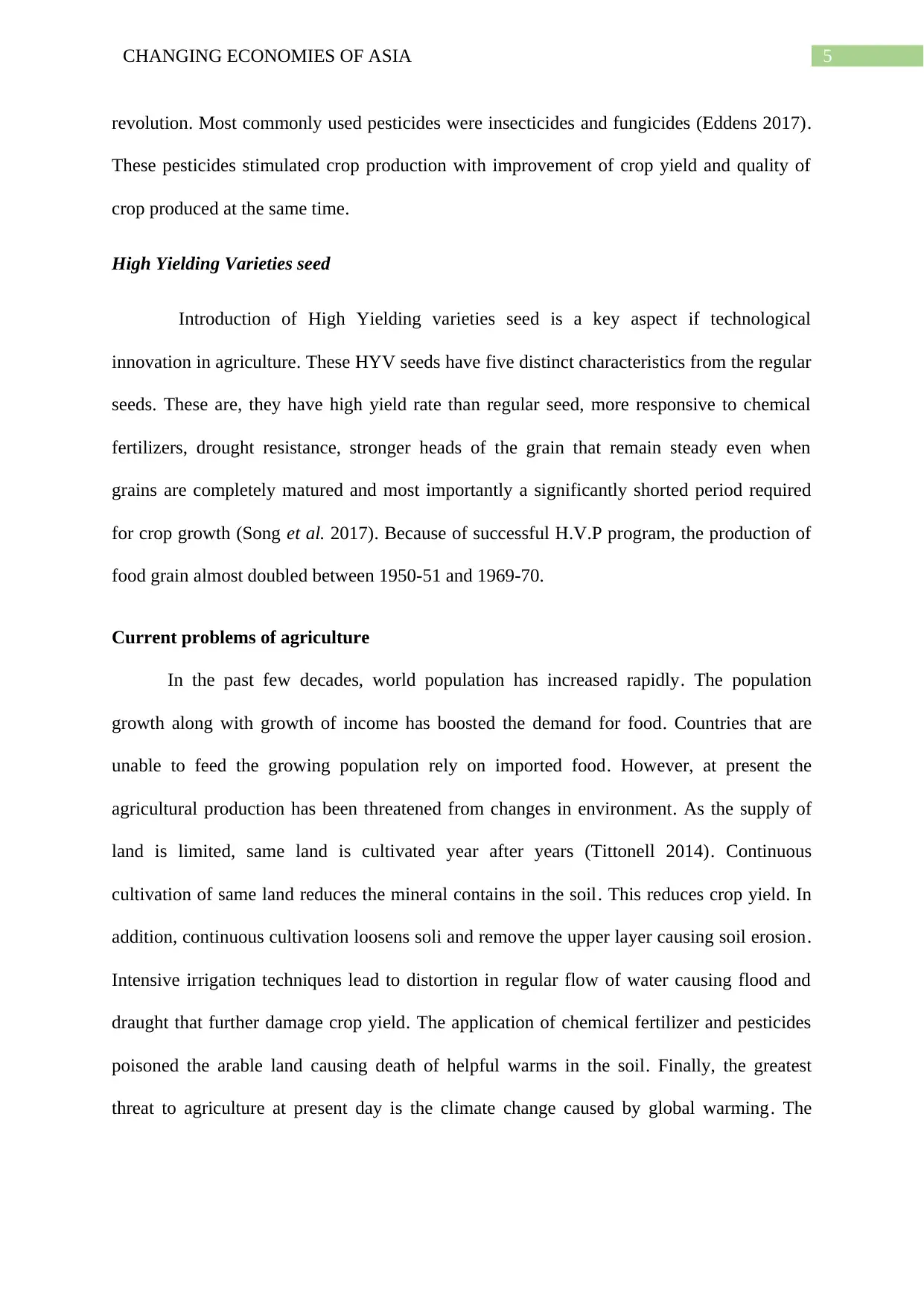
5CHANGING ECONOMIES OF ASIA
revolution. Most commonly used pesticides were insecticides and fungicides (Eddens 2017).
These pesticides stimulated crop production with improvement of crop yield and quality of
crop produced at the same time.
High Yielding Varieties seed
Introduction of High Yielding varieties seed is a key aspect if technological
innovation in agriculture. These HYV seeds have five distinct characteristics from the regular
seeds. These are, they have high yield rate than regular seed, more responsive to chemical
fertilizers, drought resistance, stronger heads of the grain that remain steady even when
grains are completely matured and most importantly a significantly shorted period required
for crop growth (Song et al. 2017). Because of successful H.V.P program, the production of
food grain almost doubled between 1950-51 and 1969-70.
Current problems of agriculture
In the past few decades, world population has increased rapidly. The population
growth along with growth of income has boosted the demand for food. Countries that are
unable to feed the growing population rely on imported food. However, at present the
agricultural production has been threatened from changes in environment. As the supply of
land is limited, same land is cultivated year after years (Tittonell 2014). Continuous
cultivation of same land reduces the mineral contains in the soil. This reduces crop yield. In
addition, continuous cultivation loosens soli and remove the upper layer causing soil erosion.
Intensive irrigation techniques lead to distortion in regular flow of water causing flood and
draught that further damage crop yield. The application of chemical fertilizer and pesticides
poisoned the arable land causing death of helpful warms in the soil. Finally, the greatest
threat to agriculture at present day is the climate change caused by global warming. The
revolution. Most commonly used pesticides were insecticides and fungicides (Eddens 2017).
These pesticides stimulated crop production with improvement of crop yield and quality of
crop produced at the same time.
High Yielding Varieties seed
Introduction of High Yielding varieties seed is a key aspect if technological
innovation in agriculture. These HYV seeds have five distinct characteristics from the regular
seeds. These are, they have high yield rate than regular seed, more responsive to chemical
fertilizers, drought resistance, stronger heads of the grain that remain steady even when
grains are completely matured and most importantly a significantly shorted period required
for crop growth (Song et al. 2017). Because of successful H.V.P program, the production of
food grain almost doubled between 1950-51 and 1969-70.
Current problems of agriculture
In the past few decades, world population has increased rapidly. The population
growth along with growth of income has boosted the demand for food. Countries that are
unable to feed the growing population rely on imported food. However, at present the
agricultural production has been threatened from changes in environment. As the supply of
land is limited, same land is cultivated year after years (Tittonell 2014). Continuous
cultivation of same land reduces the mineral contains in the soil. This reduces crop yield. In
addition, continuous cultivation loosens soli and remove the upper layer causing soil erosion.
Intensive irrigation techniques lead to distortion in regular flow of water causing flood and
draught that further damage crop yield. The application of chemical fertilizer and pesticides
poisoned the arable land causing death of helpful warms in the soil. Finally, the greatest
threat to agriculture at present day is the climate change caused by global warming. The
⊘ This is a preview!⊘
Do you want full access?
Subscribe today to unlock all pages.

Trusted by 1+ million students worldwide
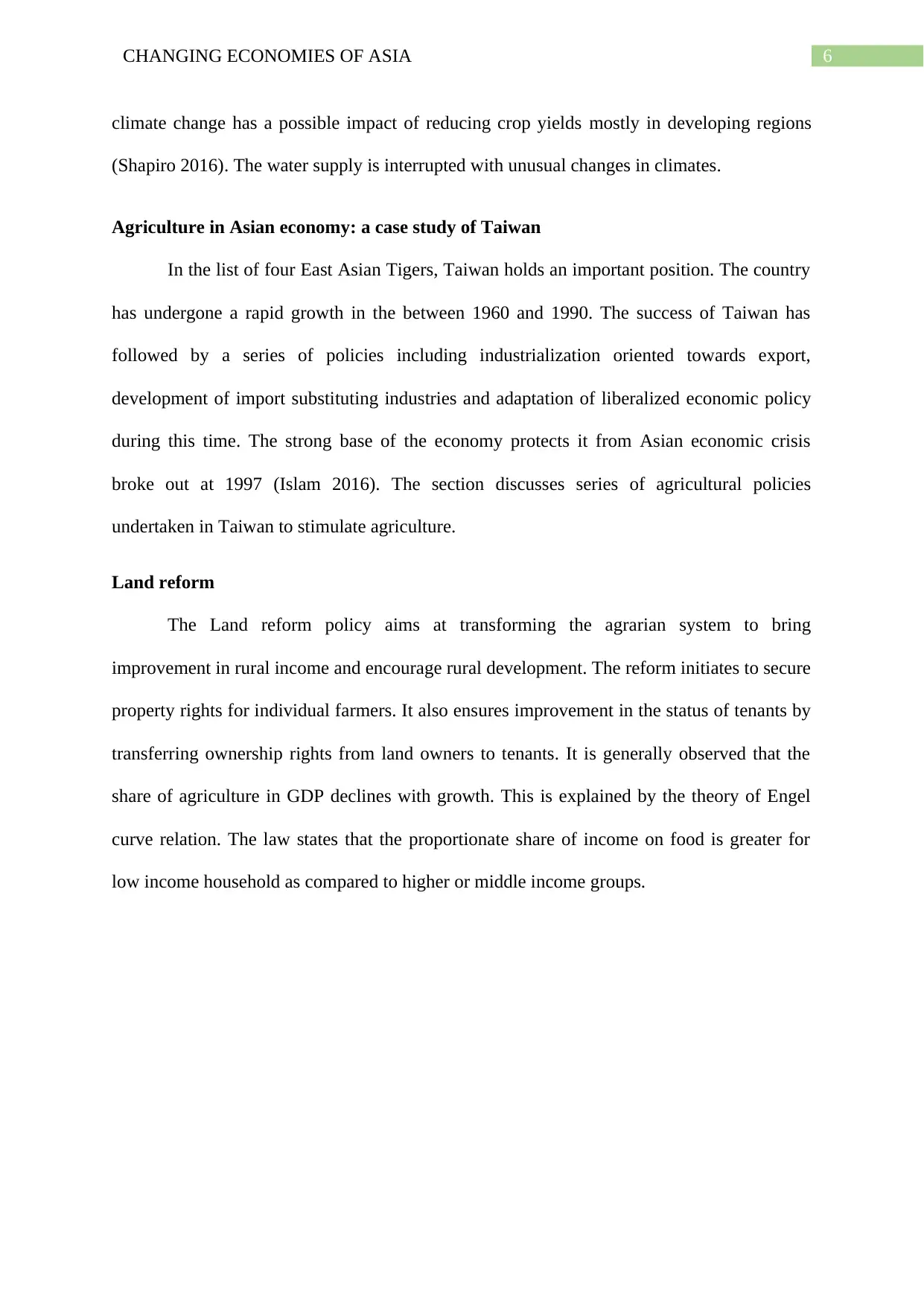
6CHANGING ECONOMIES OF ASIA
climate change has a possible impact of reducing crop yields mostly in developing regions
(Shapiro 2016). The water supply is interrupted with unusual changes in climates.
Agriculture in Asian economy: a case study of Taiwan
In the list of four East Asian Tigers, Taiwan holds an important position. The country
has undergone a rapid growth in the between 1960 and 1990. The success of Taiwan has
followed by a series of policies including industrialization oriented towards export,
development of import substituting industries and adaptation of liberalized economic policy
during this time. The strong base of the economy protects it from Asian economic crisis
broke out at 1997 (Islam 2016). The section discusses series of agricultural policies
undertaken in Taiwan to stimulate agriculture.
Land reform
The Land reform policy aims at transforming the agrarian system to bring
improvement in rural income and encourage rural development. The reform initiates to secure
property rights for individual farmers. It also ensures improvement in the status of tenants by
transferring ownership rights from land owners to tenants. It is generally observed that the
share of agriculture in GDP declines with growth. This is explained by the theory of Engel
curve relation. The law states that the proportionate share of income on food is greater for
low income household as compared to higher or middle income groups.
climate change has a possible impact of reducing crop yields mostly in developing regions
(Shapiro 2016). The water supply is interrupted with unusual changes in climates.
Agriculture in Asian economy: a case study of Taiwan
In the list of four East Asian Tigers, Taiwan holds an important position. The country
has undergone a rapid growth in the between 1960 and 1990. The success of Taiwan has
followed by a series of policies including industrialization oriented towards export,
development of import substituting industries and adaptation of liberalized economic policy
during this time. The strong base of the economy protects it from Asian economic crisis
broke out at 1997 (Islam 2016). The section discusses series of agricultural policies
undertaken in Taiwan to stimulate agriculture.
Land reform
The Land reform policy aims at transforming the agrarian system to bring
improvement in rural income and encourage rural development. The reform initiates to secure
property rights for individual farmers. It also ensures improvement in the status of tenants by
transferring ownership rights from land owners to tenants. It is generally observed that the
share of agriculture in GDP declines with growth. This is explained by the theory of Engel
curve relation. The law states that the proportionate share of income on food is greater for
low income household as compared to higher or middle income groups.
Paraphrase This Document
Need a fresh take? Get an instant paraphrase of this document with our AI Paraphraser
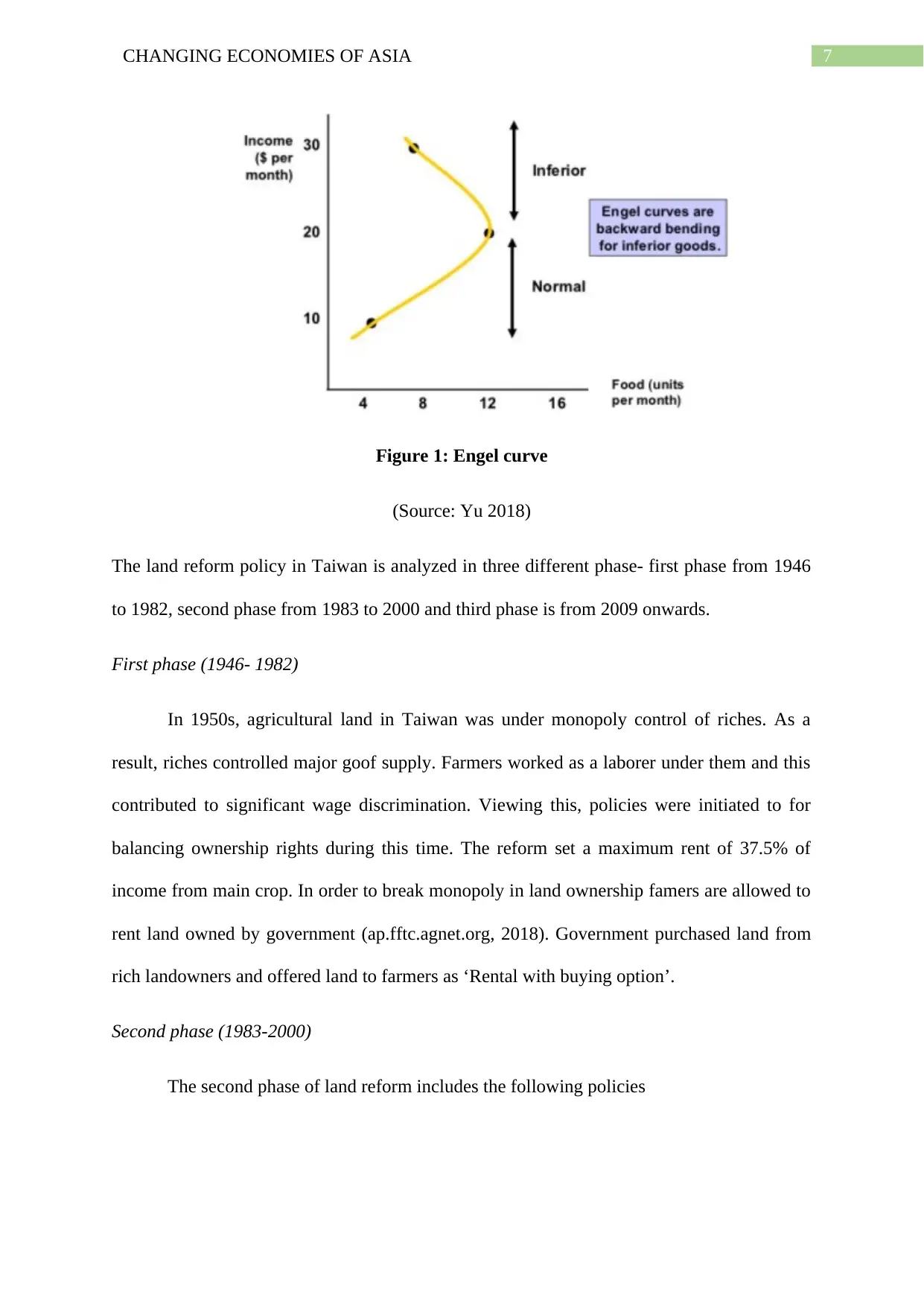
7CHANGING ECONOMIES OF ASIA
Figure 1: Engel curve
(Source: Yu 2018)
The land reform policy in Taiwan is analyzed in three different phase- first phase from 1946
to 1982, second phase from 1983 to 2000 and third phase is from 2009 onwards.
First phase (1946- 1982)
In 1950s, agricultural land in Taiwan was under monopoly control of riches. As a
result, riches controlled major goof supply. Farmers worked as a laborer under them and this
contributed to significant wage discrimination. Viewing this, policies were initiated to for
balancing ownership rights during this time. The reform set a maximum rent of 37.5% of
income from main crop. In order to break monopoly in land ownership famers are allowed to
rent land owned by government (ap.fftc.agnet.org, 2018). Government purchased land from
rich landowners and offered land to farmers as ‘Rental with buying option’.
Second phase (1983-2000)
The second phase of land reform includes the following policies
Figure 1: Engel curve
(Source: Yu 2018)
The land reform policy in Taiwan is analyzed in three different phase- first phase from 1946
to 1982, second phase from 1983 to 2000 and third phase is from 2009 onwards.
First phase (1946- 1982)
In 1950s, agricultural land in Taiwan was under monopoly control of riches. As a
result, riches controlled major goof supply. Farmers worked as a laborer under them and this
contributed to significant wage discrimination. Viewing this, policies were initiated to for
balancing ownership rights during this time. The reform set a maximum rent of 37.5% of
income from main crop. In order to break monopoly in land ownership famers are allowed to
rent land owned by government (ap.fftc.agnet.org, 2018). Government purchased land from
rich landowners and offered land to farmers as ‘Rental with buying option’.
Second phase (1983-2000)
The second phase of land reform includes the following policies
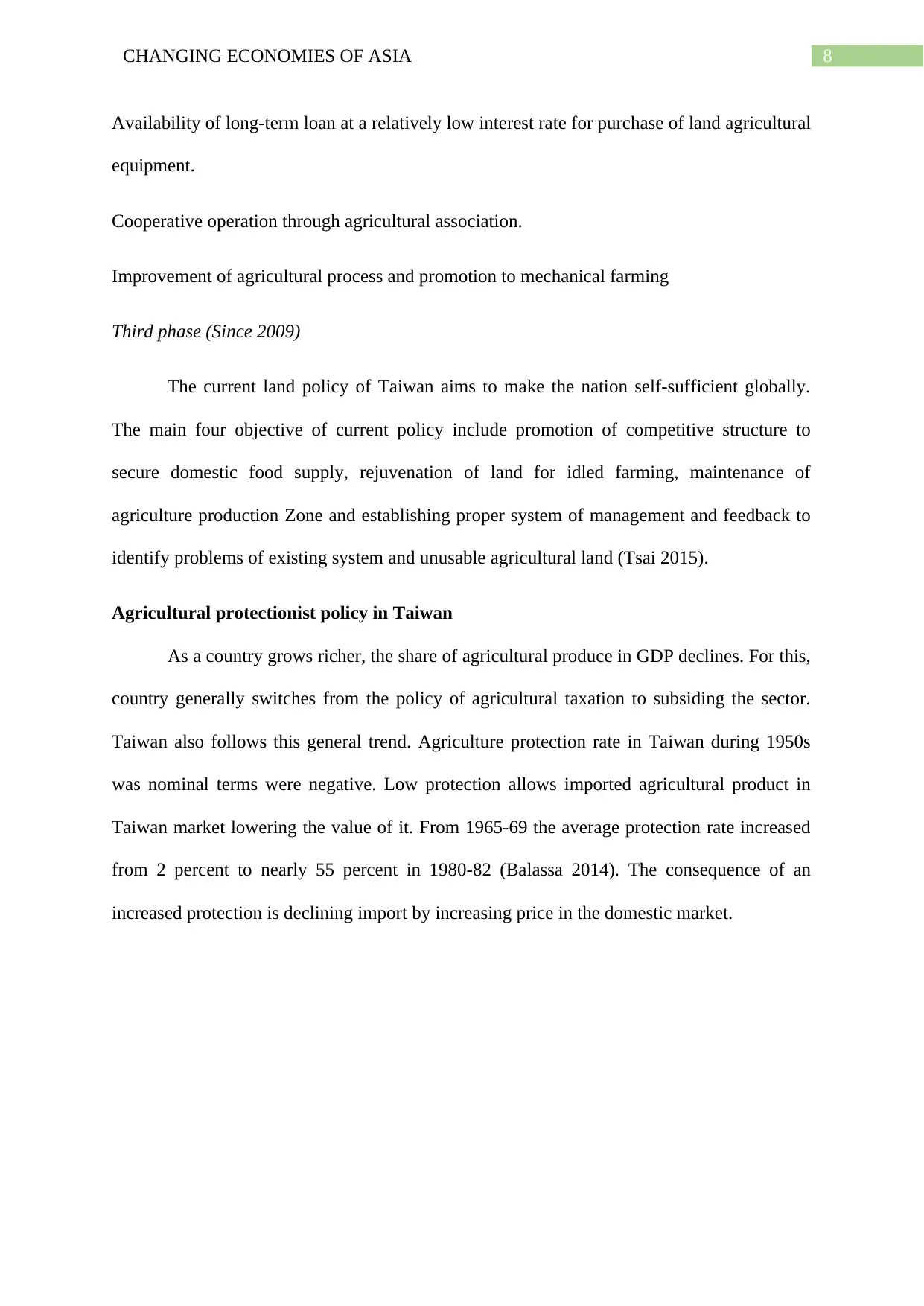
8CHANGING ECONOMIES OF ASIA
Availability of long-term loan at a relatively low interest rate for purchase of land agricultural
equipment.
Cooperative operation through agricultural association.
Improvement of agricultural process and promotion to mechanical farming
Third phase (Since 2009)
The current land policy of Taiwan aims to make the nation self-sufficient globally.
The main four objective of current policy include promotion of competitive structure to
secure domestic food supply, rejuvenation of land for idled farming, maintenance of
agriculture production Zone and establishing proper system of management and feedback to
identify problems of existing system and unusable agricultural land (Tsai 2015).
Agricultural protectionist policy in Taiwan
As a country grows richer, the share of agricultural produce in GDP declines. For this,
country generally switches from the policy of agricultural taxation to subsiding the sector.
Taiwan also follows this general trend. Agriculture protection rate in Taiwan during 1950s
was nominal terms were negative. Low protection allows imported agricultural product in
Taiwan market lowering the value of it. From 1965-69 the average protection rate increased
from 2 percent to nearly 55 percent in 1980-82 (Balassa 2014). The consequence of an
increased protection is declining import by increasing price in the domestic market.
Availability of long-term loan at a relatively low interest rate for purchase of land agricultural
equipment.
Cooperative operation through agricultural association.
Improvement of agricultural process and promotion to mechanical farming
Third phase (Since 2009)
The current land policy of Taiwan aims to make the nation self-sufficient globally.
The main four objective of current policy include promotion of competitive structure to
secure domestic food supply, rejuvenation of land for idled farming, maintenance of
agriculture production Zone and establishing proper system of management and feedback to
identify problems of existing system and unusable agricultural land (Tsai 2015).
Agricultural protectionist policy in Taiwan
As a country grows richer, the share of agricultural produce in GDP declines. For this,
country generally switches from the policy of agricultural taxation to subsiding the sector.
Taiwan also follows this general trend. Agriculture protection rate in Taiwan during 1950s
was nominal terms were negative. Low protection allows imported agricultural product in
Taiwan market lowering the value of it. From 1965-69 the average protection rate increased
from 2 percent to nearly 55 percent in 1980-82 (Balassa 2014). The consequence of an
increased protection is declining import by increasing price in the domestic market.
⊘ This is a preview!⊘
Do you want full access?
Subscribe today to unlock all pages.

Trusted by 1+ million students worldwide

9CHANGING ECONOMIES OF ASIA
Figure 2: Effect of import tariff
(Source: Balassa 2014).
Following imposition of tariff, the prices of food in Taiwan has increased more than
300 percent between 1960 and 1980. This slowed down food consumption. The open
economies like Singapore and Hong Kong, in the absence of any tariff restriction, average
food consumption has increased rapidly.
Role of Agriculture in development
In the process of development, agriculture is mostly considered as playing a
subsidiary role. The sector is regarded as important for supplementing industrial sector by
supplying raw materials. However, besides supplying raw material the sector itself plays a
vital role in feeding population and generation of employment. This section and discusses
role of agriculture in Taiwan and its importance in the economy.
Figure 2: Effect of import tariff
(Source: Balassa 2014).
Following imposition of tariff, the prices of food in Taiwan has increased more than
300 percent between 1960 and 1980. This slowed down food consumption. The open
economies like Singapore and Hong Kong, in the absence of any tariff restriction, average
food consumption has increased rapidly.
Role of Agriculture in development
In the process of development, agriculture is mostly considered as playing a
subsidiary role. The sector is regarded as important for supplementing industrial sector by
supplying raw materials. However, besides supplying raw material the sector itself plays a
vital role in feeding population and generation of employment. This section and discusses
role of agriculture in Taiwan and its importance in the economy.
Paraphrase This Document
Need a fresh take? Get an instant paraphrase of this document with our AI Paraphraser
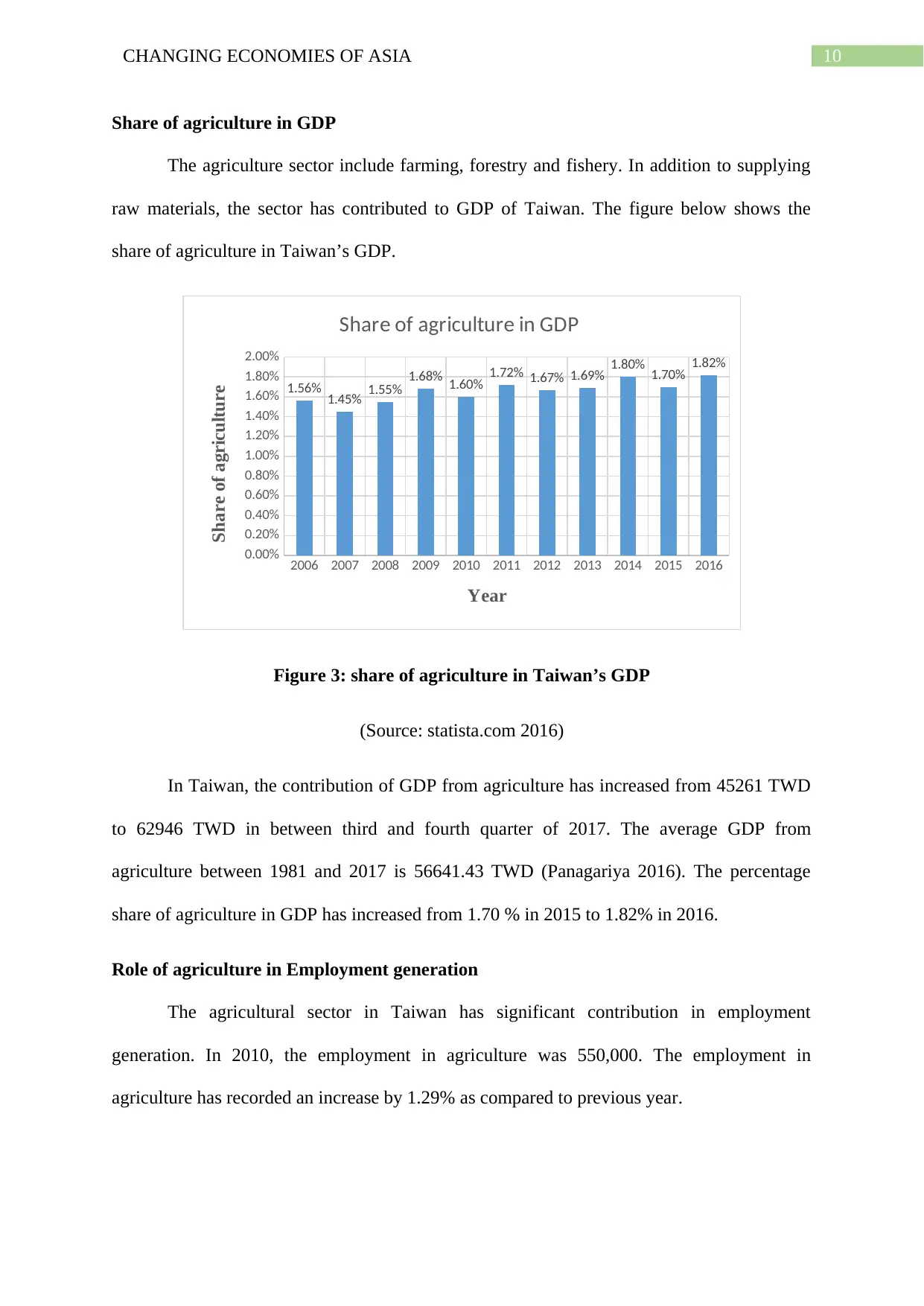
10CHANGING ECONOMIES OF ASIA
Share of agriculture in GDP
The agriculture sector include farming, forestry and fishery. In addition to supplying
raw materials, the sector has contributed to GDP of Taiwan. The figure below shows the
share of agriculture in Taiwan’s GDP.
2006 2007 2008 2009 2010 2011 2012 2013 2014 2015 2016
0.00%
0.20%
0.40%
0.60%
0.80%
1.00%
1.20%
1.40%
1.60%
1.80%
2.00%
1.56% 1.45% 1.55% 1.68% 1.60% 1.72% 1.67% 1.69% 1.80% 1.70% 1.82%
Share of agriculture in GDP
Year
Share of agriculture
Figure 3: share of agriculture in Taiwan’s GDP
(Source: statista.com 2016)
In Taiwan, the contribution of GDP from agriculture has increased from 45261 TWD
to 62946 TWD in between third and fourth quarter of 2017. The average GDP from
agriculture between 1981 and 2017 is 56641.43 TWD (Panagariya 2016). The percentage
share of agriculture in GDP has increased from 1.70 % in 2015 to 1.82% in 2016.
Role of agriculture in Employment generation
The agricultural sector in Taiwan has significant contribution in employment
generation. In 2010, the employment in agriculture was 550,000. The employment in
agriculture has recorded an increase by 1.29% as compared to previous year.
Share of agriculture in GDP
The agriculture sector include farming, forestry and fishery. In addition to supplying
raw materials, the sector has contributed to GDP of Taiwan. The figure below shows the
share of agriculture in Taiwan’s GDP.
2006 2007 2008 2009 2010 2011 2012 2013 2014 2015 2016
0.00%
0.20%
0.40%
0.60%
0.80%
1.00%
1.20%
1.40%
1.60%
1.80%
2.00%
1.56% 1.45% 1.55% 1.68% 1.60% 1.72% 1.67% 1.69% 1.80% 1.70% 1.82%
Share of agriculture in GDP
Year
Share of agriculture
Figure 3: share of agriculture in Taiwan’s GDP
(Source: statista.com 2016)
In Taiwan, the contribution of GDP from agriculture has increased from 45261 TWD
to 62946 TWD in between third and fourth quarter of 2017. The average GDP from
agriculture between 1981 and 2017 is 56641.43 TWD (Panagariya 2016). The percentage
share of agriculture in GDP has increased from 1.70 % in 2015 to 1.82% in 2016.
Role of agriculture in Employment generation
The agricultural sector in Taiwan has significant contribution in employment
generation. In 2010, the employment in agriculture was 550,000. The employment in
agriculture has recorded an increase by 1.29% as compared to previous year.
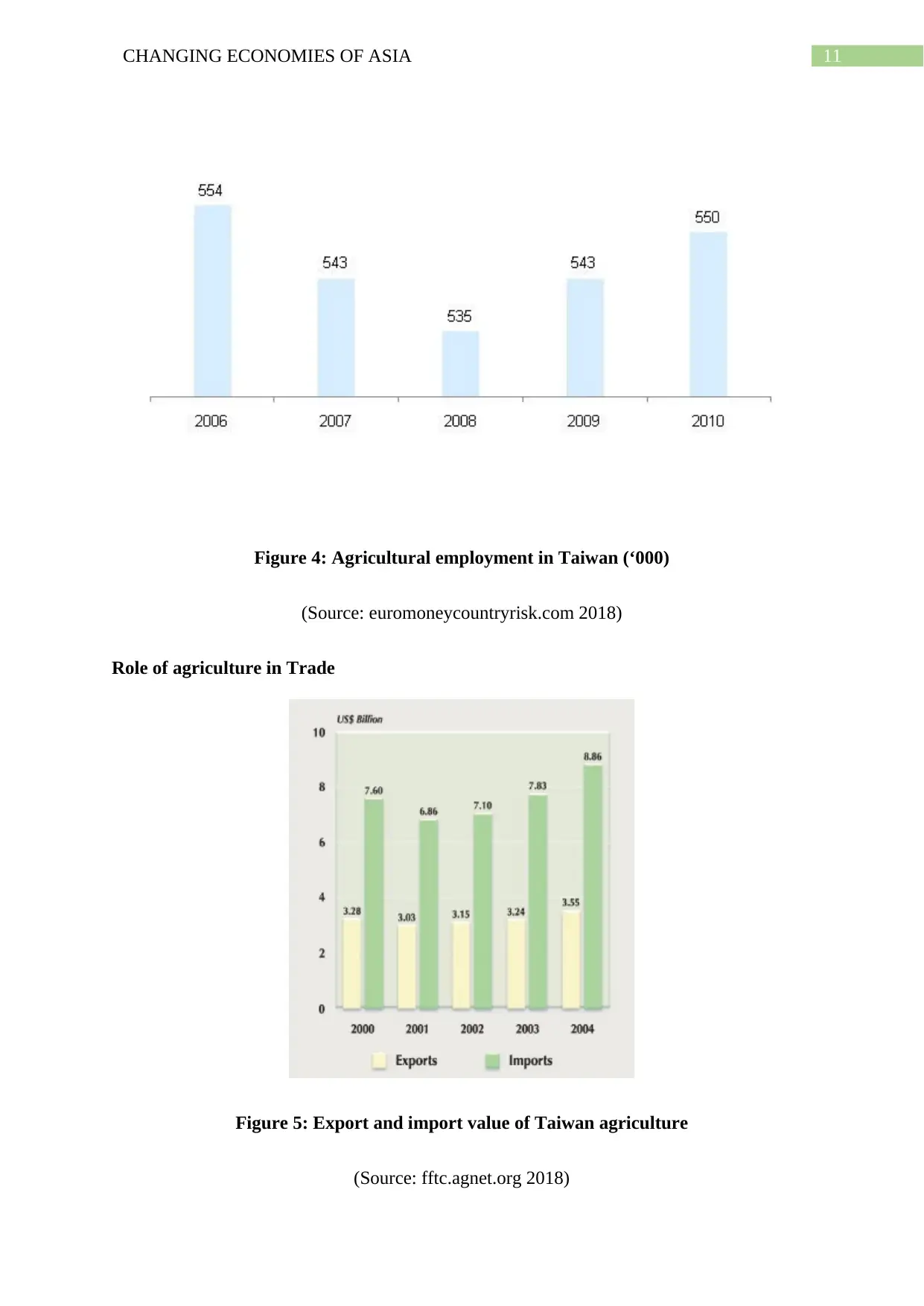
11CHANGING ECONOMIES OF ASIA
Figure 4: Agricultural employment in Taiwan (‘000)
(Source: euromoneycountryrisk.com 2018)
Role of agriculture in Trade
Figure 5: Export and import value of Taiwan agriculture
(Source: fftc.agnet.org 2018)
Figure 4: Agricultural employment in Taiwan (‘000)
(Source: euromoneycountryrisk.com 2018)
Role of agriculture in Trade
Figure 5: Export and import value of Taiwan agriculture
(Source: fftc.agnet.org 2018)
⊘ This is a preview!⊘
Do you want full access?
Subscribe today to unlock all pages.

Trusted by 1+ million students worldwide
1 out of 17
Related Documents
Your All-in-One AI-Powered Toolkit for Academic Success.
+13062052269
info@desklib.com
Available 24*7 on WhatsApp / Email
![[object Object]](/_next/static/media/star-bottom.7253800d.svg)
Unlock your academic potential
Copyright © 2020–2025 A2Z Services. All Rights Reserved. Developed and managed by ZUCOL.





